Four times a year, the Japanese designer Rei Kawakubo flies to Paris from Tokyo to show her men’s and women’s Comme des Garçons collections. In June this year she was in town for men’s fashion week, which was staged in a dilapidated mansion at 7 rue Meyerbeer. She never takes a bow at the finale. In fact she rarely gives interviews and hasn’t been professionally photographed since 2005. While she avoids publicity, she does meet the buyers who come to order from the collection each season. So we meet at the Comme des Garçons showroom at Place Vendôme, where she paces calmly, dressed in her trademark black, while staff in military-inspired garb accessorised with polka-dot shoes buzz around her.
Eleven mannequins, lined up like Qin Shi Huang’s terracotta army, display her most recent Comme des Garçons Homme Plus menswear collection, Broken Tailoring. They are adorned with neon-yellow hairpieces by stylist Julien d’Ys. The clothes include a tailored men’s blazer with a motif of golfers ripped three-quarters of the way down the back and paired with unfitted shorts. There’s a horizontally pinstriped tailored jacket obfuscated with metal buttons, shown with trousers which have one leg shorter than the other. Another pinstriped blazer has a ripped back and elbows so the shirt underneath shows through.
“The primary objective of this collection is not specifically for kids to wear the clothes as streetwear, but to comment on the current state of menswear, which is easy, casual and based on sports. I see the collection as an addition to the discussion on menswear,” explains Kawakubo, “where tailoring is broken down to add value to it. I want to show people that tailoring has value, which I don’t see any more in men’s fashion.”
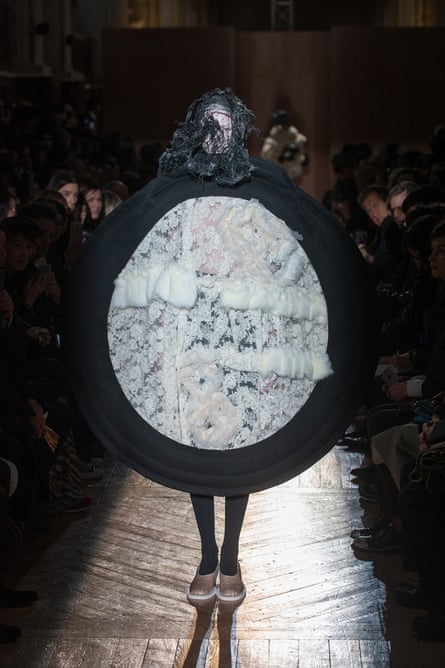
We head to her office at the back of the showroom with her husband, Adrian Joffe, who is president of Comme des Garçons International and also acts as her translator. The glass-walled office is elevated so you can look down on the showroom, the universe Kawakubo has created. Her influence is such that it’s fair to say she has forever changed the way clothes are viewed, worn and bought. Usually when a designer challenges everyday ideas as radically as Kawakubo, it’s a commercial liability. But she is as much a businesswoman as she is a creative. “The first thing you need in order to make a business viable is to preserve a cash flow. I made sure I didn’t have any financial backing or support,” says Kawakubo. “I was always very careful to work within my means – I never departed from that. I was adamant to never carry debt.”
The brand has 230 storefronts and franchise outlets outside Japan, 17 unique brands under the Comme des Garçons brand, three flagship locations in New York, Paris and Tokyo, and an annual turnover of $250m. She has a fervent fanbase, not only among customers but also other designers. Karl Lagerfeld, Nicolas Ghesquière, creative director of Louis Vuitton, and Céline creative director Phoebe Philo are fans, as is Marc Jacobs, who wears her skirts for men. Jacobs has said he likes Kawakubo’s clothes because “it’s not about dressing for other people. It’s not about buying clothes to attract or seduce. It feels like a gift you’re giving yourself.”
For someone who has such singular ideas, Kawakubo has excelled at collaborating and diversifying over the years. She has nurtured the talent of her protégés, allowing them to develop labels of their own. Since his debut in 1992, her ex-pattern cutter Junya Watanabe has become one of the fashion world’s most innovative and influential designers. And in 2012 she launched a new collection by another of her former pattern cutters, Kei Ninomiya, called Noir Kei Ninomiya.
In 2009, Kawakubo even released a one-off bag collection called The Beatles Comme des Garçons in collaboration with Apple Corporation. She has collaborated with Mick Jagger, Cindy Sherman and Ai WeiWei. Last year she teamed up with Pharrell Williams to create the scent Girl. “Although I do not believe in fame,” she says, “what it brings me is the fact that I can ask someone to work with me and they do not say no.” Her fragrance business, begun in 1994, is booming.
She’s a genius at retail as well as design. She started the trend of the guerilla or pop-up shops that have proliferated over the past decade, and she asked architects Future Systems to collaborate on a Comme Des Garçons store in New York in 1998, three years before Miuccia Prada created a similar temple to fashion with Rem Koolhaas in the city. But her biggest innovation has been the Dover Street Markets, fashion department stores which now have shops in London, New York, Beijing and Tokyo. They act as galleries as much as shops, curating the new and the wonderful names of fashion. Dover Street Market’s shop windows have become the ultimate destination for any designer, whether new or established. This week the London windows will be handed over to the new designer at Gucci, Alessandro Michele. Rei Kawakubo’s blessing is worth more to Gucci than a hundred celebrity endorsements.
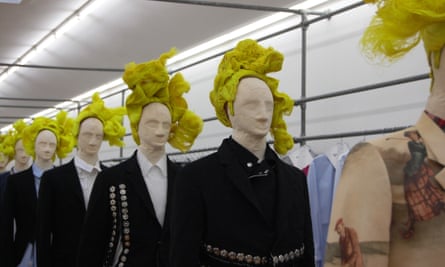
“I wanted to present high fashion in a store reminiscent of a street market,” she says. “The Dover Street Markets bring brands of all disciplines together to sell their products in an open atmosphere that, most importantly, incites creativity.” They are, along with the Comme des Garçons stores, usually located in areas off the beaten track. Next year, the original Dover Street Market will move from the office block it took over in genteel Dover Street in Mayfair in 2004 to a bigger site in the grand old Burberry store on Haymarket.
Rei Kawakubo’s designs have always been personal, driven by a sense of independence. Her father was a university administrator and her mother a teacher. After studying history of aesthetics at Keio University in the 60s, she left home and found work in the advertising department of textile manufacturer Ashai Kasei. The job included looking for props and costumes and eventually she started designing those she couldn’t find. She finally went freelance as a stylist and designer in 1967. “The very first thing I wanted to do when I started this was to make a living, be independent and have a job. But I could never find clothes that I wanted to wear, so I decided to make them myself.’
Without any formal fashion training, she launched Comme des Garçons in 1969, with the first boutique opening in Tokyo’s Minami-Aoyama district in 1973. From the beginning she had unorthodox ways of working. “I attempted a different approach to the typical clothing storefront, which was usually adorned with mannequins dressed in the latest collections for everyone to see, clothes on view for the masses to lust over. The front display windows of the first boutique in Aoyama were often kept vacant while the clothes remained in the back room of the shop. I would make the clothes, bring them to the boutique and interact with clients daily. There were no mirrors in the boutique to emphasise the notion that one should buy clothes because of how they make you feel, not how they make you look.”
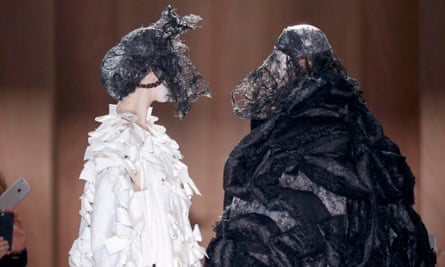
Kawakubo has said that she just likes the sound of the words that make her company’s name, but the spirit of “like boys” chimed with women’s liberation in the 60s and 70s, and her designs have always challenged traditional ideas of femininity. “I’ve always been against people who told me what to do,” she says. She identified with the punk movement in London in the late 70s and visited the city twice in the early 80s. When she first showed in Paris in 1981, fashion was dominated by the high glamour of Gianni Versace and Thierry Mugler. Dynasty and Falcon Crest debuted on American TV that year and Human League was the bestselling band in the UK. This was the world into which Kawakubo sent that first collection of black, shapeless garments with asymmetric hems, odd flaps, laddered knits and shredded fabric. It was a signature style that had earned her fans at home the nickname Karasu – “the crows” – by the Japanese press. “I built my work from within instead of satisfying a demand for sexualised and ostentatious clothing,” she says.
But the collection was dismissed by critics as “ragged chic”. It was also attacked on a political level, labelled “Hiroshima chic” or “post atomic”. Kawakubo says her work was misunderstood. “Although I never went hungry I remember well the extreme poverty and devastation of those times. But this had no bearing on my work whatsoever. These critics had it all wrong. Being born in Japan was an accident. There is no direct correlation to my work. Growing up in postwar Japan has made me the person I am, but it is not why I do the work I do. It is a very personal thing – everything comes from inside.”
Personal it may be, but Kawakubo has constantly pushed against preconceived ideas of how women should dress. Other notable shows over the years include 1997’s Dress Meets Body, Body Meets Dress featuring figure-hugging gingham clothes accessorised with deforming padded humps (Adrian Joffe has said this collection was inspired “by Rei’s anger at seeing a Gap shop window filled with banal black clothes”); 2005’s The Broken Bride, with its geisha make-up and antique veils; and the 2012 collection in which she tried to make her collection look two dimensional. The models walked the runway in silence. In an interview around the time of the 2D collection she complained about the state of fashion: “There is a kind of burnout – people just want cheap fast clothes and are happy to look like everyone else. That enthusiasm and passionate anger for change and rattling the status quo is weakening.”
But season after season, Kawakubo can be relied upon to produce collections that are consistent in their ability to surprise her audience. Her collections are often difficult to understand – sometimes they are almost comical (and Kawakubo does have a deadpan sense of humour).
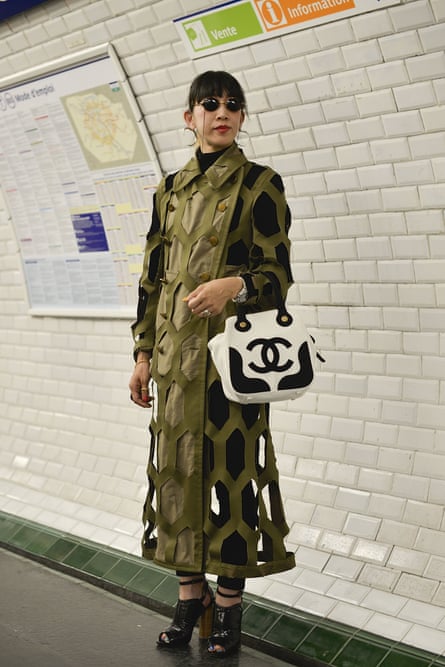
Her latest collection is called Ceremony of Separation. For her catwalk presentation, a series of 18 faceless models walked the catwalk clad in what appeared to be bundles of duvets, parcels of laundry tied up in pillowcases, black lace tied up together to form a human mountain, an oversized three-tiered black-lace Victorian mourning shroud enveloping the model. Critics linked the sombre, melancholic collection to the displacement of war-torn peoples. But for Kawakubo, the show “had nothing to do with politics or wars. It’s about something deeper, some horror solidly anchored in me, in us. The impetus was also about the sense of loss, someone dear leaving, but also the ceremonial ritual accompanying this departure that could make things bearable. There is very little creation without despair.”
After the show there was speculation that it might have been Kawakubo’s final collection. “Word comes that… this time it has taken so much out of her to produce the latest collection, there really might not be another one,” reported Vogue. However, she tells me she is not thinking of retiring any time soon. She has always talked about how each collection is “an exercise in suffering”, that no idea can ever be used twice.
And, at 72, she is still at the helm of her company, never compromising and always refusing outside investments. “There is no difference between creation and business,” she says. “A good collection doesn’t necessarily mean a prosperous business. The business aspect of a company has to be creative, innovative, transformative, it has to espouse the creative in total osmosis. It is just as important as a piece of new tailoring in the sense that one is an extension of the other, but I see it as a whole. This is a fragile equilibrium and why I refused to bring a financial backer into the company.”
It’s a path even more at odds with the world of fashion – a landscape now dominated by conglomerates such as LVMH and Kering, with their focus on spreadsheets and bottom lines – than when she started more than 50 years ago. Will the search for the next new retail concept, the next new design, ever feel too much? Does she ever feel enslaved to the search for the new? Kawakubo thinks for a moment and then replies: “You can’t be enslaved to something you choose.”
Additional reporting by Emily Lembo
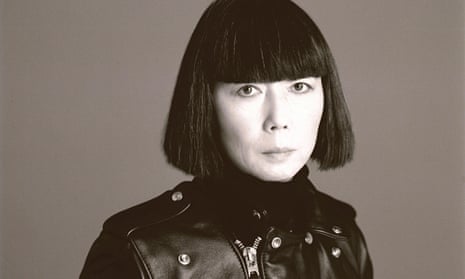
Comments (…)
Sign in or create your Guardian account to join the discussion